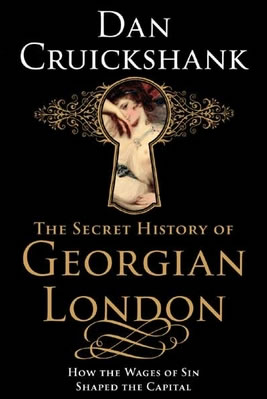 When George Eliot (then Mary Ann Evans) came to London from the Midlands in 1851 to work for the Westminster Review in the Strand, she was advised to keep away from the side streets. It was good advice. Then, as now, and as Dan Cruickshank shows, from the early 18th century, the streets around Drury Lane and Charing Cross were the heart of London’s sex industry. These bordered the great thoroughfare running east from the Royal Exchange, along Fleet Street, to St. James’s Park, linking the financial and trade centre of the City with the political power base of aristocratic West London.
When George Eliot (then Mary Ann Evans) came to London from the Midlands in 1851 to work for the Westminster Review in the Strand, she was advised to keep away from the side streets. It was good advice. Then, as now, and as Dan Cruickshank shows, from the early 18th century, the streets around Drury Lane and Charing Cross were the heart of London’s sex industry. These bordered the great thoroughfare running east from the Royal Exchange, along Fleet Street, to St. James’s Park, linking the financial and trade centre of the City with the political power base of aristocratic West London.
Cruickshank’s scholarly, disturbing book challenges the reader from the start: was it worse then than now? Were there proportionally more whores, pimps, bordellos and dubious doorways than can be seen today? And what percentage of young girls arriving as strangers in the capital are still driven to sell their only saleable commodity?
He is clear that during the 18th century London had more prostitutes plying their trade openly on the streets than any other city in Europe. When Charles II granted letters patent for the Theatre Royal Drury Lane, the district became even more than it was already the magnet for sex sellers and buyers.
This sordid history offers at the start the view of the artist William Hogarth, whose six paintings, “The Harlot’s Progress” (showing her from innocence to recruitment, degradation, gaol and death), threw out the challenge. In Cruickshank’s words, this question was “What will you do to help save this girl, all such girls, from the cruelty and corrupting immorality of London life?”
It is good to be reminded that there were some decent citizens who tried to alleviate the misery, notably Captain Thomas Coram, whose “Foundling Hospital for Exposed and Deserted Children”, a beautiful building completed in the early 1750s, aimed to take in abandoned babies. The statistics Cruickshank assembles are fascinating. The hospital was soon so overwhelmed by numbers – 100 children abandoned there in one week – that a large percentage died. At first the Foundling Hospital received generous government aid, but this was withdrawn in disillusion with the mortality statistics. Nonetheless, the hospital entered the 19th century on a firm footing. Pitiful evidence remains: scraps of crumbling paper showing mothers’ anguish at leaving their babies at the gate.
Perversely, social reformers such as William Wilberforce, who campaigned for the abolition of slavery, virtually ignored the plight of common harlots enslaved by the sex industry. Even the Society for the Suppression of Vice ignored prostitution and dedicated itself to protecting the religion and morals of the country. Cruickshank judges that for these reformers the sex industry was too close to home and too vital a part of the economy of the capital to be suppressed or even seriously hampered. As Town and Country Magazine declared in July 1778, only half in jest, “a man of taste, to establish his reputation, must have a mistress as well as a pastry cook.”
That there was a bright side to sex in the Georgian city was shown by the astonishing success of The Beggar’s Opera in 1728, celebrating the low life of Macheath and his harlots. However, Mary Young, who was the original Polly Peachum, came to no such cheerful reprieve at the end. Transported once, then returned, she was tried for “theft and highway robbery”. Wearing an elegant black dress, bonnet and veil, she was hanged at Tyburn in 1741 – along with nineteen other condemned criminals the same day.
Cruickshank, an architectural historian as well as television presenter, offers well-researched evidence that the profits of the sex trade made possible the building of the elegant Georgian London we all admire and cherish. He has provided a rich social and architectural history. The risk is that, with its catalogue of drugs, syphilis and child prostitution, you may be left loving London less.
The Secret History of Georgian London is published by Random House

